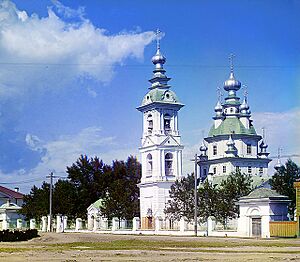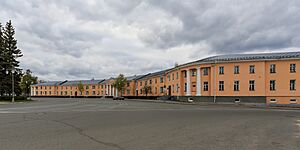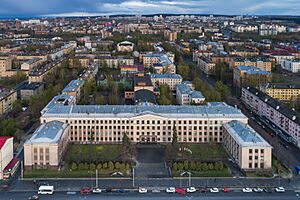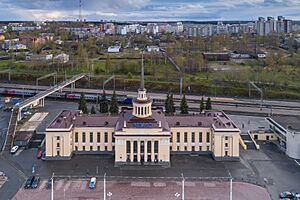Petrozavodsk facts for kids
Quick facts for kids Petrozavodsk (English)Петрозаводск (Russian) Petroskoi (Karelian) |
|
|---|---|
| - City - | |
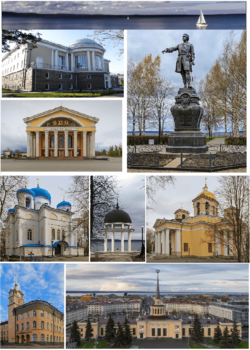 Petrozavodsk Bay, National Library of Karelia, Music Theater, Monument to Peter I, Church of Exaltation of Holy Cross on Zaretskoe Cemetery, Roundabout on the embankment of Lake Onega, Alexander Nevsky Cathedral, Main post office, Railway station |
|
|
|
|
| City Day | Last Saturday of June |
| Administrative status | |
| Country | Russia |
| Federal subject | Republic of Karelia |
| Administratively subordinated to | city of republic significance of Petrozavodsk |
| Capital of | Republic of Karelia |
| Municipal status | |
| Urban okrug | Petrozavodsky Urban Okrug |
| Mayor | Inna Kolykhmatova |
| Representative body | City Council |
| Statistics | |
| Area | 135 km2 (52 sq mi) |
| Population (2010 Census, preliminary) |
261,987 inhabitants |
| - Rank in 2010 | 71st |
| Density | 1,941/km2 (5,027/sq mi) |
| Time zone | MSK (UTC+04:00) |
| Founded | 1703 |
| City status since | March 21, 1777 |
| Postal code(s) | 185000–185003, 185005, 185007, 185009–185016, 185019, 185023, 185026, 185028, 185030–185035, 185700, 185890, 185899, 185910, 185960–185963, 185965, 185970, 185980–185983, 185985 |
| Dialing code(s) | +7 8142 |
| Official website: http://www.petrozavodsk-mo.ru/ | |
Petrozavodsk (Russian: Петрозаводск; Karelian, Vepsian and Finnish: Petroskoi) is the capital city of the Republic of Karelia, Russia. It stretches along the western shore of Lake Onega for about 27 kilometers. In 2022, the city had a population of 280,890 people.
Contents
About the Name of Petrozavodsk
The name Petrozavodsk comes from two words: "Peter" (referring to Peter the Great) and "zavod" (which means factory).
Earlier Names of the City
Before it was called Petrozavodsk, the city had other names. From 1703 to 1704, it was known as Shuysky Zavod. Then, from 1704 to 1777, it was called Petrovskaya Sloboda. This was the first name that honored Peter the Great.
The city was officially renamed Petrozavodsk when Catherine the Great made it an official city. An old Swedish map from 1592 shows a place called Onegaborg in this area. This name was later translated into Finnish as Äänislinna. This Finnish name was used when Finnish forces occupied the area during World War II (1941–1944).
History of Petrozavodsk
People have lived in the Petrozavodsk area for a very long time. Archeologists have found signs of settlements from as far back as seven thousand years ago. During the Middle Ages, there were several villages along Lake Onega where the city is now. One part of the city, Solomennoje, has been mentioned in records since the 1500s. A map from the late 1500s by a Flemish mapmaker, Abraham Ortelius, even shows a settlement called Onegaborg here.
Founding of the City
On September 11, 1703, Aleksandr Danilovich Menshikov, a close friend of Tsar Peter the Great, founded a settlement called Petrovskaya Sloboda. Peter the Great wanted a new iron factory to make cannons and anchors for his Baltic Fleet during the Great Northern War (1700–1721).
At first, the factory was called Shuysky zavod, meaning "factory at the Shuya River." About ten years later, it became Petrovsky zavod, or "Petrine factory," named after Tsar Peter. This is where the city's current name comes from.
By 1717, Petrovskaya Sloboda was the biggest settlement in Karelia. It had about 3,500 people, a wooden fort, a market, and small palaces for the Tsar and Menshikov. A famous landmark was the wooden church of Saint Peter and Saint Paul. This church was rebuilt in 1772 and fixed up in 1789. Sadly, its original altar, a relic from Peter the Great's time, was destroyed in a fire in 1924.
After Peter the Great died, Petrovskaya Sloboda became less populated, and the factory closed in 1734.
City Revival and Growth
The industry started up again in 1773 when Catherine the Great opened a new iron factory. This factory, named Alexandrovsky after Alexander Nevsky, made cannons for the Russo-Turkish Wars. The factory was improved between 1787 and 1796. Some local historians say that the world's first industrial railway was built here in 1788 for the Alexandrovsky factory.
In 1777, during Catherine's city reforms, Petrovskaya Sloboda became an official town and was renamed Petrozavodsk. A new city center was built in a Neoclassical style, with the Round Square at its heart. By 1784, Petrozavodsk was big enough to become the main administrative center of the region, taking over from Olonets.
During the Finnish occupation in World War II (1941–1944), the city was called Äänislinna. This name was a Finnish translation of Onegaborg, an old name for a settlement near the city. During this time, 11 concentration camps were opened in the city.
In 1977, Petrozavodsk was at the center of a strange event called the Petrozavodsk phenomenon, where people reported seeing unusual lights in the sky.
City Government
Petrozavodsk is the capital of the Republic of Karelia. It is also the administrative center for Prionezhsky District, even though it's not officially part of that district. The city has its own local government, known as the Petrozavodsky Urban Okrug. The city's leader is called the Mayor, and the current mayor is Inna Kolykhmatova. The city's decisions are made by the City Council.
Famous Places in Petrozavodsk
Petrozavodsk is known for its beautiful Neoclassical architecture. This style can be seen in places like the Round Square, which was built in 1775, and the Alexander Nevsky Cathedral, finished in 1832.
You can also find statues of important figures like Peter I (Peter the Great), Gavrila Derzhavin (a Russian poet and former governor), and Alexander Nevsky.
The city has a lovely waterfront along the Gulf of Petrozavodsk. The modern embankment, built in 1994, shows off different types of Karelian granite and marble. It features unique sculptures given by Petrozavodsk's sister cities from around the world. There's also a birch tree area where the first church of Petrozavodsk was built in 1703.
Petrozavodsk is home to many cultural and educational places. These include the Karelia Philharmonic Orchestra (started in 1933), the Karelian Musical Theater (1955), the National Library of Karelia (1959), and the Finnish-speaking National Theatre of Karelia (1965). It also has Petrozavodsk State University, a music conservatory, a city museum (founded in 1871), and a branch of the Russian Academy of Sciences.
One of the city's main landmarks is Lenin Square. It's an oval-shaped space with a large statue of Lenin from the Soviet era in the middle. It's sometimes called "round square," which sounds funny in English but makes sense in Russian (kruglaya ploshad).
Nearby Areas to Explore
Near Petrozavodsk, in the village of Shoksha, there's a quarry that produces red and pink quartzite. This special stone, called Shoksha quartzite, was used to build famous structures like Saint Isaac's Cathedral and the Lenin Mausoleum. Other quarries in the area dig up materials for roads.
The suburb of Martsialnye Vody is Russia's oldest spa. It was founded by Peter the Great in 1714, and he visited it four times. Its name means "The Waters of Mars." While Peter's original palace there no longer exists, there is a museum about the spa's history.
From Petrozavodsk Harbor, you can take a hydrofoil boat to Kizhi island. Kizhi is a World Heritage Site with an outdoor museum showcasing amazing old wooden buildings.
Getting Around Petrozavodsk
By Car
Petrozavodsk is about 1010 km from Moscow and 412 km from St. Petersburg. The distance to Finland along the "Blue Highway" is less than 350 km. The main federal highway, Invalid type: E Invalid type: R «Kola» (which goes from St. Petersburg to Murmansk and Norway), passes through the city. Petrozavodsk is also the starting point for other regional roads.
By Train
Petrozavodsk station is an important railway hub. Trains connect the city to Saint Petersburg, Murmansk, Sortavala, and Kostomuksha.
The railway system is run by the October Railway. In 2005, parts of the railway were electrified. There's a special train called "Karelia" that goes between Petrozavodsk and Moscow. Other trains connect Petrozavodsk to St. Petersburg and Kostomuksha. In 2012, a trial train service began between Petrozavodsk and Joensuu in Finland.
Local train services are provided by the "North-Western Suburban Passenger Company."
By Trolleybus
Trolleybuses started running regularly in Petrozavodsk on September 5, 1961. As of November 2009, there were 110 trolleybuses in use.
As of June 2022, Petrozavodsk has 5 trolleybus routes. The total length of the trolleybus wires is 95.5 kilometers. The fare for a ride is 38 rubles (as of January 1, 2023). In 2022, the city began buying new trolleybuses.
By Bus
Bus service in Petrozavodsk began on May 9, 1915. The first bus was a five-seater car. The city's official bus fleet started in 1921. Buses are still an important way to get around Petrozavodsk today.
By Air
Petrozavodsk has its own airport, which helps people travel to and from the city by air.
Petrozavodsk Weather
| Climate data for Petrozavodsk (1991–2020, extremes 1816–present) | |||||||||||||
|---|---|---|---|---|---|---|---|---|---|---|---|---|---|
| Month | Jan | Feb | Mar | Apr | May | Jun | Jul | Aug | Sep | Oct | Nov | Dec | Year |
| Record high °C (°F) | 5.5 (41.9) |
7.3 (45.1) |
15.5 (59.9) |
24.2 (75.6) |
33.0 (91.4) |
34.3 (93.7) |
33.9 (93.0) |
32.4 (90.3) |
28.5 (83.3) |
21.3 (70.3) |
11.1 (52.0) |
9.4 (48.9) |
33.9 (93.0) |
| Mean daily maximum °C (°F) | −5.7 (21.7) |
−5.2 (22.6) |
0.0 (32.0) |
6.7 (44.1) |
13.8 (56.8) |
18.8 (65.8) |
21.5 (70.7) |
19.3 (66.7) |
13.6 (56.5) |
6.4 (43.5) |
0.2 (32.4) |
−3.3 (26.1) |
7.2 (45.0) |
| Daily mean °C (°F) | −8.4 (16.9) |
−8.2 (17.2) |
−3.5 (25.7) |
2.5 (36.5) |
8.9 (48.0) |
14.1 (57.4) |
17.1 (62.8) |
15.0 (59.0) |
10.0 (50.0) |
3.8 (38.8) |
−1.9 (28.6) |
−5.6 (21.9) |
3.7 (38.7) |
| Mean daily minimum °C (°F) | −11.4 (11.5) |
−11.4 (11.5) |
−6.9 (19.6) |
−1.3 (29.7) |
4.1 (39.4) |
9.4 (48.9) |
12.7 (54.9) |
11.1 (52.0) |
6.8 (44.2) |
1.5 (34.7) |
−4.1 (24.6) |
−8.1 (17.4) |
0.2 (32.4) |
| Record low °C (°F) | −41.6 (−42.9) |
−39.3 (−38.7) |
−30.0 (−22.0) |
−19.3 (−2.7) |
−9.8 (14.4) |
−2.6 (27.3) |
−0.1 (31.8) |
−1.7 (28.9) |
−5.0 (23.0) |
−13.4 (7.9) |
−27.5 (−17.5) |
−36.8 (−34.2) |
−41.6 (−42.9) |
| Average precipitation mm (inches) | 38 (1.5) |
29 (1.1) |
31 (1.2) |
32 (1.3) |
48 (1.9) |
61 (2.4) |
82 (3.2) |
81 (3.2) |
59 (2.3) |
56 (2.2) |
51 (2.0) |
44 (1.7) |
612 (24.1) |
| Average extreme snow depth cm (inches) | 16 (6.3) |
21 (8.3) |
22 (8.7) |
5 (2.0) |
0 (0) |
0 (0) |
0 (0) |
0 (0) |
0 (0) |
0 (0) |
5 (2.0) |
11 (4.3) |
22 (8.7) |
| Average rainy days | 4 | 3 | 6 | 11 | 16 | 18 | 18 | 18 | 20 | 19 | 11 | 6 | 150 |
| Average snowy days | 26 | 24 | 20 | 10 | 4 | 0.3 | 0 | 0 | 1 | 8 | 20 | 27 | 140 |
| Average relative humidity (%) | 87 | 85 | 80 | 70 | 66 | 71 | 75 | 80 | 84 | 86 | 89 | 89 | 80 |
| Mean monthly sunshine hours | 18.2 | 53.5 | 135.5 | 192.4 | 271.5 | 285.1 | 286.9 | 226.2 | 131.8 | 59.7 | 18.1 | 5.2 | 1,684.1 |
| Source 1: Погода и Климат | |||||||||||||
| Source 2: NOAA | |||||||||||||
Petrozavodsk has a climate that is cold but not as extreme as some other places in Russia at the same latitude. This is because of the milder air coming from the Atlantic Ocean and the Baltic Sea. This also means the weather can change quickly, especially in winter.
Winters are long and cold, but still milder than expected for such a northern city. Summers are short and warm. The city has about 161 days of frost each year. The nearby lakes also help keep summer nights mild. Autumn usually starts with clear, cool weather in September. On average, Petrozavodsk gets about 611 mm of rain or snow each year.
Famous People from Petrozavodsk
Many notable people come from Petrozavodsk, including:
- Vladimir Drachev, a biathlete (someone who competes in cross-country skiing and rifle shooting)
- Denis Zubko, a football player
- Sergey Katanandov, who was the Head of the Republic of Karelia from 2002 to 2010
- Anastasia Maksimova, a Rhythmic Gymnast
- Timur Dibirov, a handball player
- Irina Sidorkova, a racing driver
Sister Cities of Petrozavodsk
Petrozavodsk has "sister city" relationships with many cities around the world. This means they share cultural and educational exchanges. Here are some of them:
 Alytus, Lithuania
Alytus, Lithuania Brest, Belarus
Brest, Belarus Duluth, United States
Duluth, United States Joensuu, Finland
Joensuu, Finland Narva, Estonia
Narva, Estonia Neubrandenburg, Germany
Neubrandenburg, Germany Rana, Norway
Rana, Norway La Rochelle, France
La Rochelle, France Tübingen, Germany
Tübingen, Germany Umeå, Sweden
Umeå, Sweden Vagharshapat, Armenia
Vagharshapat, Armenia Varkaus, Finland
Varkaus, Finland
Images for kids
See also
 In Spanish: Petrozavodsk para niños
In Spanish: Petrozavodsk para niños



